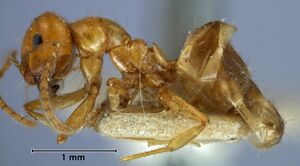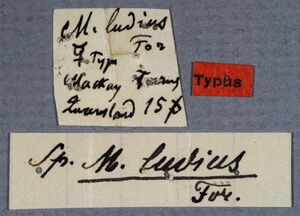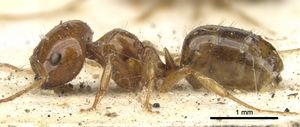Melophorus ludius
| Melophorus ludius | |
|---|---|

| |
| Scientific classification | |
| Kingdom: | Animalia |
| Phylum: | Arthropoda |
| Class: | Insecta |
| Order: | Hymenoptera |
| Family: | Formicidae |
| Subfamily: | Formicinae |
| Tribe: | Melophorini |
| Genus: | Melophorus |
| Species group: | ludius |
| Species complex: | ludius |
| Species: | M. ludius |
| Binomial name | |
| Melophorus ludius Forel, 1902 | |
Melophorus ludius, a minute species, is common throughout a wide range of habitats throughout all mainland Australian states, but the majority of records have come from the southern states, generally in wetter areas. However, there is no doubt this tiny ant is one of the more adaptable members of its genus. (Heterick et al. 2017)
Identification
Heterick et al. (2017) - Melophorus ludius is placed in the Melophoprus ludius species-group on the basis of molecular data. However, in morphological appearance this taxon shares major diagnostic characters with the Melophoprus biroi complex (viz, metatibia of major worker with only one preapical spur; clypeal psammophore placed anteriorly at or just above anterior margin of clypeus in the minor worker and often in the major worker; legs compact, and small body size [HW of smallest minor < 0.40 mm, HW of largest major < 1.10 mm]). Like the other three members of its species-group, M. ludius is characterized by being weakly sculptured overall, with the cuticle of the mesosoma visibly thin, the mesonotum being translucent to varying degrees and the mesopleuron either smooth or with vestigial sculpture only. Melophorus ludius is distinguished from Melophorus pusillus by the smaller eye (EI in M. ludius 19-30 compared with 31-40 in M. pusillus) and from Melophorus translucens by the shorter propodeum and propodeal spiracle (both rather elongate in M. translucens), and, as regards the major worker, the less bulbous and rather more opaque mesonotum.
While varying in colour from pale yellow to brown (concolorous or bicoloured), the species can be distinguished by the shiny, barely sculptured cuticle, rounded head and moderate-sized eye in the minor worker and additional features of the clypeus in the major worker. Major workers have fine, often flexuous setae on the pronotum, and this feature, the narrower width of the clypeus and the more sloping propodeum distinguish them from Melophorus biroi workers of similar appearance. The M. biroi workers of all sub-castes also tend to be more matt and shagreenate in appearance than M. ludius workers. Based on the appearance of the type specimens and other material from QLD, minor workers of Melophorus ludius sensu stricto from the east coast are larger, always bicoloured with yellow foreparts and brown gaster and have a longer scape than have their counterparts in WA. They also tend to be hairier, and such differences may be taxonomically significant. However, no material from eastern Australian localities was available for genetic research.
Despite its apparently unremarkable morphology, M. ludius is distantly removed from Melophorus biroi and its relatives on all molecular trees and appears to have some connection with the very aberrant Melophorus potteri. A three-gene tree places it as the sister species to M. pusillus, which it very closely resembles, the chief difference being the large eye of the latter. Just the one sample of the western form of M. ludius has been available for sequencing, but this has been sufficient to indicate the distant relationship to M. biroi despite its convergent morphology.
Distribution
Common throughout a wide range of habitats throughout all mainland Australian states.
Latitudinal Distribution Pattern
Latitudinal Range: -16.3895° to -16.8608°.
| North Temperate |
North Subtropical |
Tropical | South Subtropical |
South Temperate |
- Source: AntMaps
Distribution based on Regional Taxon Lists
Australasian Region: Australia (type locality).
Distribution based on AntMaps
Distribution based on AntWeb specimens
Check data from AntWeb
Countries Occupied
| Number of countries occupied by this species based on AntWiki Regional Taxon Lists. In general, fewer countries occupied indicates a narrower range, while more countries indicates a more widespread species. |

|
Estimated Abundance
| Relative abundance based on number of AntMaps records per species (this species within the purple bar). Fewer records (to the left) indicates a less abundant/encountered species while more records (to the right) indicates more abundant/encountered species. |

|
Biology
Heterick et al. (2017) - Ecological data, while sparse as usual given the number of pinned specimens, indicates the many habitats from which this ant has been collected throughout Australia. One label note records nesting in sand, and the associated vegetation mentioned on labels includes dry sclerophyll, mallee (burned in a couple of instances), Eucalyptus maculata open forest, Eucalyptus largiflorens woodland, sandstone scrub, paddock, Casuarina woodland, and mulga bushland. Sequenced material has also been collected from red loam soil and from a parking bay. Queensland Museum material includes ants taken from a nest under a rock. As is the case with Melophorus dicyrtos, QM workers include a couple of samples taken from faeces-baited pitfall traps. The species is common in some urban situations in the Perth metropolitan area, where tiny workers can be seen foraging on suburban lawns. Because of their minute size, depigmented appearance and the rapidity of their movement over the ground, the principal author finds they can be difficult to distinguish from acarine Prostigmata (Teneriffiidae?) of the same size that move in similar fashion over the ground in the same locations. Given its ubiquity, this species is likely to be generalist in its habits.
Castes
Worker
           
| |
| . | |
Images from AntWeb
   
| |
| Syntype of Melophorus ludius. Worker. Specimen code casent0903267. Photographer Will Ericson, uploaded by California Academy of Sciences. | Owned by NHMUK, London, UK. |
Phylogeny
| Melophorus |
| ||||||||||||||||||||||||||||||||||||
Based on Heterick et al., 2017. Only selected species groups/complexes are included.
Nomenclature
The following information is derived from Barry Bolton's Online Catalogue of the Ants of the World.
- ludius. Melophorus ludius Forel, 1902h: 484 (s.w.) AUSTRALIA. Current subspecies: nominal plus sulla.
Unless otherwise noted the text for the remainder of this section is reported from the publication that includes the original description.
Description
Worker
Heterick et al. (2017) - (n = 8): CI 90–116; EI 19–30; EL 0.12–0.20; HL 0.44–0.91; HW 0.39–1.05; ML 0.55–1.18; MTL 0.30–0.66; PpH 0.05–0.11; PpL 0.24–0.50; SI 83–120; SL 0.47–0.88.
Minor. Head. Head rectangular; posterior margin of head weakly convex; frons shining and smooth except for piliferous pits; frons consisting exclusively or almost exclusively of well-spaced, appressed setae only (small, erect setae, if present, usually confined to ocular triangle or posterior margin of head). Eye moderate (eye length 0.20–0.49 length of side of head capsule); in full-face view, eyes set at about midpoint of head capsule; in profile, eye set around midline of head capsule; eyes elliptical or slightly reniform. In full-face view, frontal carinae distinctly concave; frontal lobes curved toward antennal insertion. Anteromedial clypeal margin straight; clypeal psammophore set at or just above anterior clypeal margin; palp formula 6,4. Five mandibular teeth in minor worker; mandibles triangular, weakly incurved; third mandibular tooth distinctly shorter than apical tooth and teeth numbers two and four; masticatory margin of mandibles approximately vertical or weakly oblique. Mesosoma. Integument of pronotum, mesonotum and mesopleuron shining and mainly smooth, vestigial shagreenation most noticeable on humeri and mesopleuron; anterior mesosoma in profile smoothly rounded anteriad, thereafter pronotum and whole of mesonotum flattened and on same plane as propodeum; erect pronotal setae absent in western populations but one or two erect setae may be present in eastern populations; in profile, metanotal groove shallow, indicated mainly by an angle; propodeum shining and smooth or with superficial and almost invisible microsculpture; propodeum angulate, propodeal angle blunt; length ratio of propodeal dorsum to its declivity between 1:1 and1:2; erect propodeal setae always absent; appressed propodeal setulae sparse or absent, if present then not regularly spaced; propodeal spiracle situated on or beside declivitous face of propodeum, and longer (length ≥ 0.50 × height of propodeum). Petiole. In profile, petiolar node squamiform; in full-face view, shape of petiolar node uniformly rounded; node shining and smooth with vestigial sculpture. Gaster. Gaster shining with superficial microreticulation; pilosity of first gastral tergite consisting of well-spaced short, inconspicuous, appressed setae only in western populations, erect setae always absent; minor workers in eastern populations may possess one or two erect gastral setae on first gastral tergite. General characters. Colour light brown or yellow tan, concolorous or bicoloured (gaster always darker in bicoloured workers).
Major. Head. Head square; posterior margin of head planar or weakly concave; cuticle of frons shining and smooth except for piliferous pits; frons consisting exclusively or almost exclusively of well-spaced, appressed setae only (small, erect setae, if present, usually confined to ocular triangle or posterior margin of head). Eye moderate (eye length 0.20–0.49 length of head capsule); in profile, eye set at about midpoint of head capsule; in full-face view, eye set around midline of head capsule; eyes elliptical. In full-face view, frontal carinae straight, divergent posteriad; frontal lobes straight in front of antennal insertion. Anterior clypeal margin straight; clypeal psammophore set below midpoint of clypeus; palp formula 6,4. Five mandibular teeth in major worker; mandibles triangular, weakly incurved; third mandibular tooth distinctly shorter than apical tooth and teeth numbers two and four; masticatory margin of mandibles approximately aligned vertically or weakly oblique. Mesosoma. Integument of pronotum, mesonotum and mesopleuron shining with indistinct microsculpture that is most pronounced on lower surfaces; anterior mesosoma in profile pronotum smoothly rounded anteriad and flattened posteriad, mesonotum narrowly convex; erect pronotal setae long (i.e., longer than length of eye) and unmodified; in profile, metanotal groove shallow, broadly V- or U-shaped; propodeum shining and finely striolate and microreticulate; propodeum always smoothly rounded; propodeal dorsum and declivity confluent; erect propodeal setae variable in number, may be absent; appressed propodeal setae sparse or absent, if present then not regularly spaced; propodeal spiracle situated on or beside declivitous face of propodeum, and shorter (length less than 0.50 × height of propodeum). Petiole. In profile, petiolar node squamiform; in full-face view, shape of petiolar node uniformly rounded, or tapered with sharp vertex; node shining and faintly striolate and microreticulate. Gaster. Gaster shining with superficial microreticulation; pilosity of first gastral tergite consisting of well-spaced, erect and semi-erect setae interspersed with regularly spaced appressed setae. General characters. Colour of foreparts shades of yellow, orange or light tan, gaster brown.
Type Material
Heterick et al. (2017) - Syntype major and minor workers (two pins): Mackay, Queensland Musee d'Histoire Naturelle Genève (examined: MHNG specimens). Note: An Automontaged major and minor worker (2 × four views, AntWeb, CASENT0903266 and CASENT0903267, respectively) lack Forel’s hand-written labels and red ‘typus’ label, and may in fact not be syntypes. The blue ‘syntype’ label should therefore be treated with suspicion, although syntype status cannot be automatically excluded (see ICZN, section 73.2). Both specimens are the property of the The Natural History Museum.
- Syntype, worker(s), Mackay, Queensland, Australia, Musee d'Histoire Naturelle Genève.
References
- Forel, A. 1902j. Fourmis nouvelles d'Australie. Rev. Suisse Zool. 10: 405-548 (page 484, soldier, worker described)
- Heterick, B.E. 2021. A guide to the ants of Western Australia. Part I: Systematics. Records of the Western Australian Museum, Supplement 86, 1-245 (doi:10.18195/issn.0313-122x.86.2021.001-245).
- Heterick, B.E. 2022. A guide to the ants of Western Australia. Part II: Distribution and biology. Records of the Western Australian Museum, supplement 86: 247-510 (doi:10.18195/issn.0313-122x.86.2022.247-510).
- Heterick, B.E., Castalanelli, M., Shattuck, S.O. 2017. Revision of the ant genus Melophorus (Hymenoptera, Formicidae). ZooKeys 700, 1–420 (doi: 10.3897/zookeys.700.11784).
References based on Global Ant Biodiversity Informatics
- Heterick B. E., M. Lythe, and C; Smithyman. 2012. Urbanisation factors impacting on ant (Hymenoptera: Formicidae) biodiversity in the Perth metropolitan area, Western Australia: Two case studies. Urban Ecosyst. DOI 10.1007/s11252-012-0257-3

